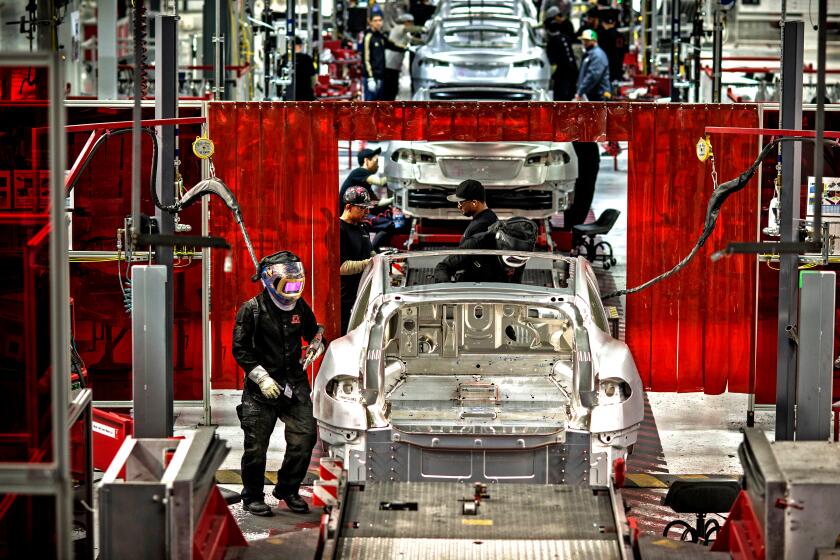It’ll make your head spin
The four-seat Mazda RX-8 offers unprecedented opportunities to make your loved ones woozy.
The “Rx” is a prescription-strength emetic for anybody in the rear seats when this fervid little coupe is in full thrash mode. The back seat -- though surprisingly roomy and accessible thanks to the car’s fascinating demi-doors -- ranks up there with the aft cabin of a Porsche 911 coupe on the “are-we-there-yet” list. I spent half an hour in the RX-8’s steerage compartment and was left clinging to the smoky glass like one of those Garfield dolls.
So, with all due respect to the paradigm floggers who created what is indisputably a four-seat sports car, I must tell you: The driver’s seat is the place to be.
At first blush, the RX-8’s mission statement -- a successor to the sublime RX-7, only with two more seats and two fewer turbochargers -- might seem as unpromising as conflict resolution counseling in Fallouja. But the RX-8 design has seasoned well over its nearly decade-long development (the car was largely designed at the Mazda Design Studio in Irvine). It is, first of all, a wonderful example of space efficiency. The new Renesis engine is lighter and more compact than the RX-7’s twin-turbo whirligig, allowing it to be situated lower and farther back, for a lower center of gravity and lower polar inertia (it changes direction more quickly). Mazda calls this a front-midship layout. So does Nissan. Ahoy, jargon.
The design situates all the heavy stuff -- cabin, engine and transmission, gas tank and the steel cat’s cradle that reinforces the extra-large door openings -- between the axles and divvies the weight of the car (3,029 pounds in the six-speed manual) evenly between the front and rear axles for a 50/50 weight balance. These sums get thrown off quite a bit, however, if you load the RX-8 to its capacity with two golf bags in the trunk and two overfed golf buddies in the rear seats. That’s a lot of kippers to pack in a can just more than 174 inches in length.
The clean and technical exterior styling sends all the right signals. The alloy wheels twirl inside prominent, perfect-circle wheel arches seemingly laser-cut into the body and fused together by a strong character line in the lower body. The shoulder line slopes forward like the lines of a recumbent bike while the greenhouse is low and narrow. With its laughing-android face and bobbed butt, the RX-8 is somewhere between fierce and winsome, but it clearly has a visual valence to the asphalt beneath it, a look that defines the car as a high-energy surface-skimmer.
The design conceals the cut-lines around the rear doors so that from a distance you might not even distinguish it from a typical sport coupe. Like Saturn’s third door design, the RX-8’s rear-hinged “freestyle” doors -- it sounds better than “suicide” -- can be opened only after the front doors are open. Latches at the top and bottom of the back doors rotate the interlocking pins that secure the doors to the frame and act as part of the door system’s anti-intrusion design. The trailing edges of the front doors are reinforced with a vertical side-impact safety bar.
The car seems to fold around you as you alight in the deep-socket driver’s seat. The high shoulder line and the low floor create an ergonomic space like that of a race boat cockpit, where you’re buried up to your chin in machinery. Thanks to a compact motor, the hood slopes away for good forward visibility. In the rear seats, however, the visibility is quite limited -- so it’s hard to lock your eyes on the horizon for vestibular relief. Mazda would probably say the seats are for occasional use. That occasion is hurling.
It would be a shame to despoil the car’s lovely, lacquered interior. The seats, door gussets and steering wheel are stitched in contrasting leathers while polished alloys on the pedals, instrument console and shifter imbue the cabin with Photoshop-quality highlights. The instrument lighting changes from blue to red when the lights are switched on (a little bit of sport-tuner sizzle come to the mass market). I’m not mad about the melange of audio and climate controls in the central stack, however, and the plastic that is supposed to pass for piano-black is a few lumens too glossy to be believed. Still, it’s a sweet piece of automotive cabinetry.
In motion, the rear-drive RX-8 has the frictionless agility and Beretta lightness of an oversized Miata. The chassis is stiffer than a soap-opera exit line. The electric-assist steering is heavy, taut and reactive. As you drive the car hard you grow increasingly sure of where the limits are and how far you can exceed them before reeling the car back in. The disc brakes come on like retro-rockets, and the pedal feels finely modulated. As with the Miata, confidence is standard equipment.
Even though the rotary engine, with its inherent lack of internal inertia, doesn’t require a lot of heel-and-toe downshifting, car guys will want to keep in practice. The pedals are small and perfectly placed so you can cover the throttle and brake with the right foot.
Out there in the g-loading zone, it’s plain that the car’s weight under-taxes the 18-inch Bridgestone tires. Our test car had Silas Marner’s own grip on the asphalt. The car has a modest degree of factory-installed understeer -- the tendency to resist turning inputs near the limits of grip -- that your local tuning shop could dial out in about an hour. And while it’s possible to waggle the rear end loose by chopping the throttle at the entrance to a corner, the relative lack of horseflesh makes it hard to rotate the car under power. You could, if you were feeling generous, credit the limited-slip differential, which is designed to stop wheel slippage during a turn.
This is where it all gets a bit sticky for the RX-8. The signature piece in the car is the rotary engine, which produces most of its 238 horsepower in the stratosphere (8,500 rpm). With its divergent lines on the dynamometer (the 159 pound-feet of torque peaks at 5,500 rpm) the RX-8 requires you to stir the stubby shifter like witches at the caldron in “Macbeth.”
And even though the “high-power” rotary is smoother than Tony Blair in the House of Commons, I felt a little -- what’s the word, guilty? -- tormenting the throttle. One simply cannot make a stately progress away from a stoplight. You have to hit the buzzer to get moving before an MTA bus runs you down.
Mazda offers an alternative: an RX-8 with a four-speed automatic and a detuned version of the Renesis reactor (197 horsepower), packaged with smaller wheels and tires, brakes, and various other short-sheeting for a base price of $25,180. I don’t think this car can give up that kind of power and still remain faithful to the creed.
Agile? Compared to the RX-8, bumblebees have wings of clay. Clever? Getting four proper seats between a 106.4-inch wheelbase ought to earn Mazda the Nobel Prize for packaging. Fun? More than a roomful of circus seals. Fast? Can we go back to “fun” again?
The RX-8 offers everything but big sports car power, which is easy to forgive except if you take the car to be a true replacement for the RX-7. It isn’t, not without turbocharging, which may or may not be in the offing. And because the rotary engine design isn’t particularly fuel efficient, the RX-8 gets only average gas mileage -- a bit less, actually, than a pushrod GM V-6 of comparable output.
These days, that’s enough to put you off your lunch.
*
2004 Mazda RX-8
Wheelbase: 106.4 inches
Length: 174.3 inches
Curb weight: 3,029 pounds
Powertrain: Naturally aspirated 1.3-liter rotary engine, six-speed manual transmission, rear-wheel drive.
Horsepower: 238 at 8,500 rpm
Acceleration: 0 to 60 mph in 6.3 seconds
EPA rating: 18 miles per gallon city, 24 mpg highway
Price, base: $26,680*
Price, as tested: $33,734 ($520 destination)
*$25,180 with four-speed automatic
Source: Mazda, Car and Driver magazine
*
Automotive critic Dan Neil can be reached at dan.neil@latimes.com.



